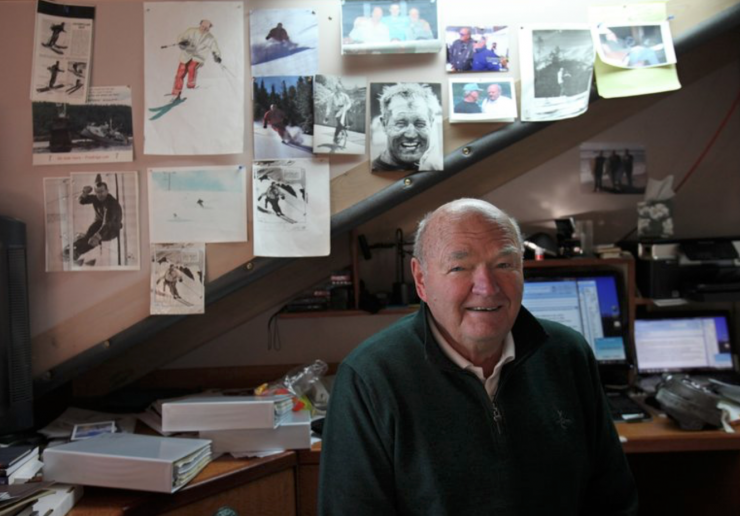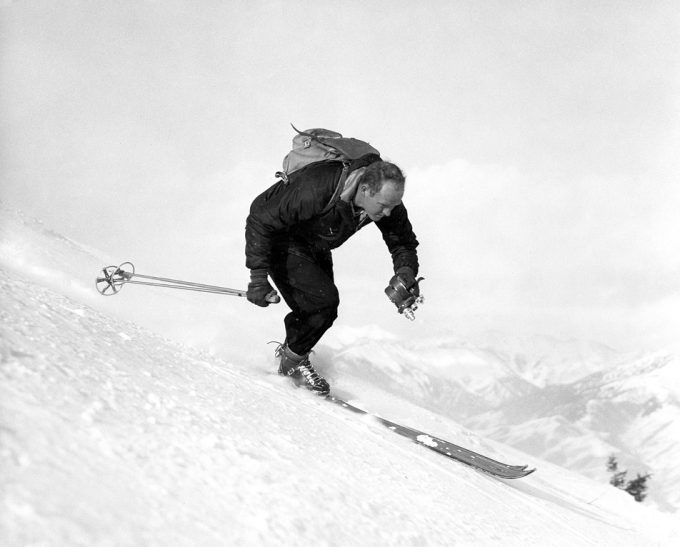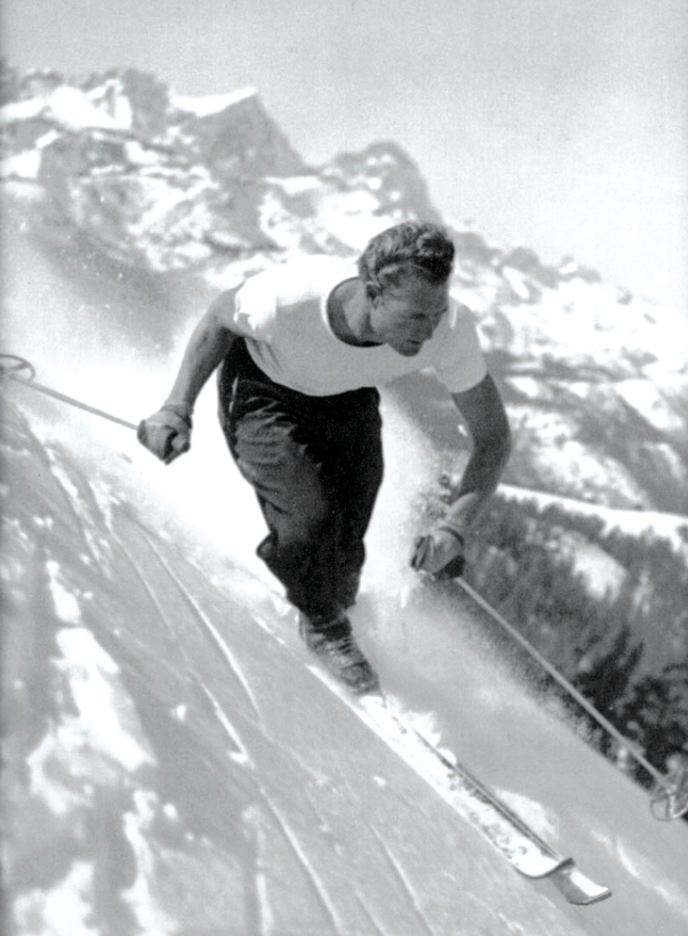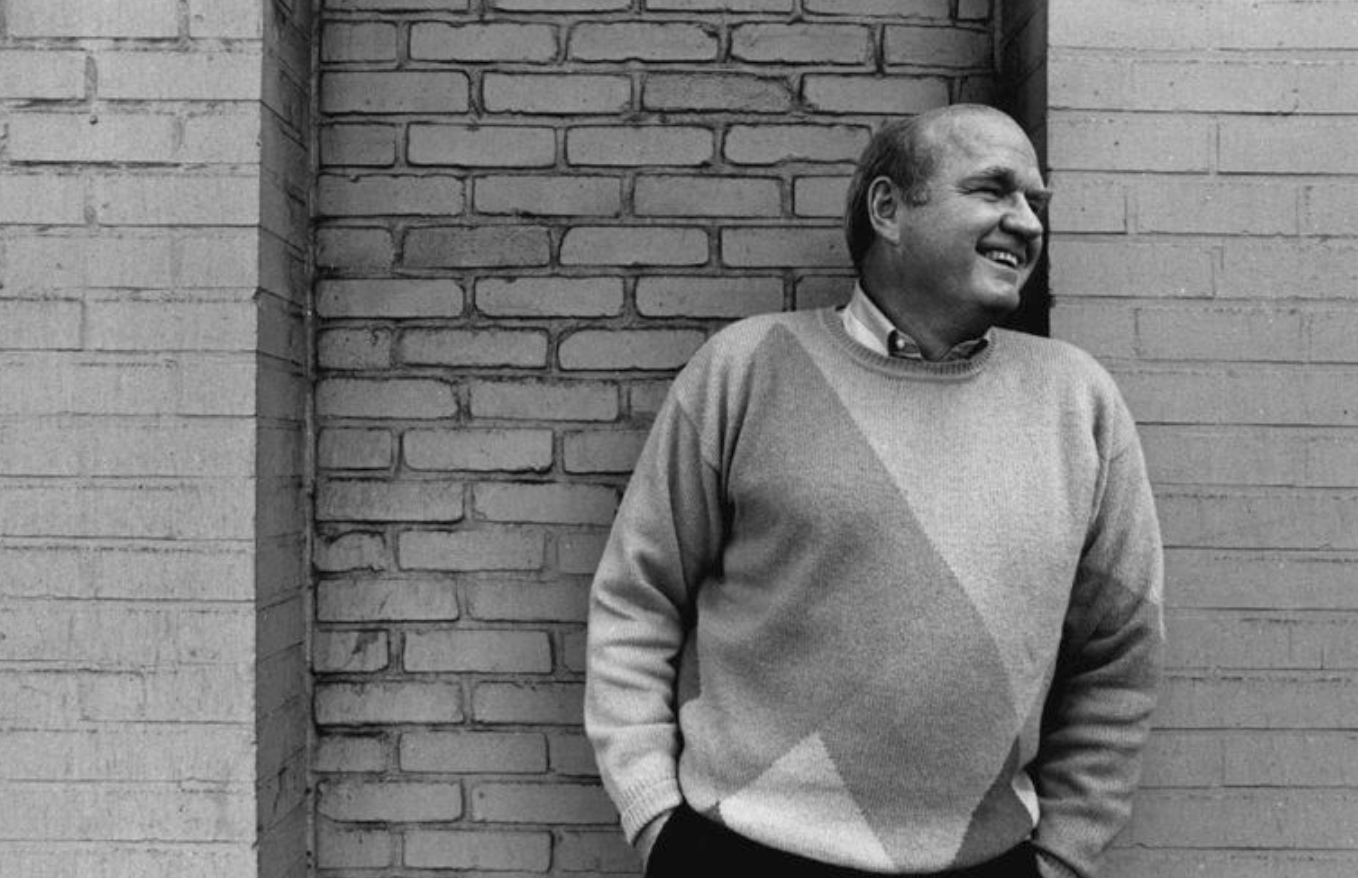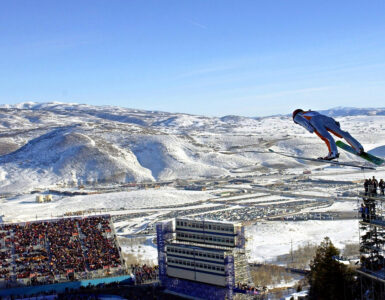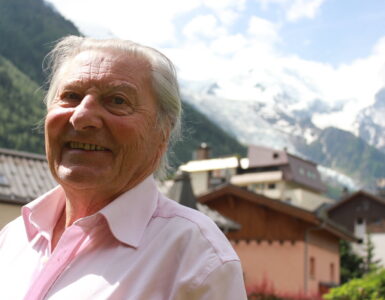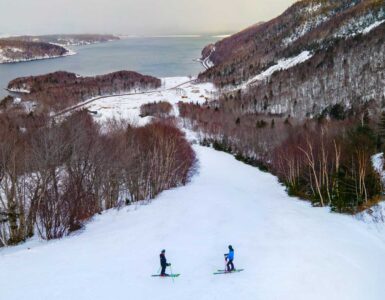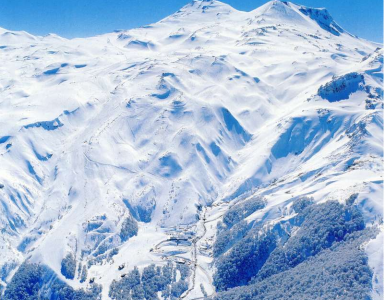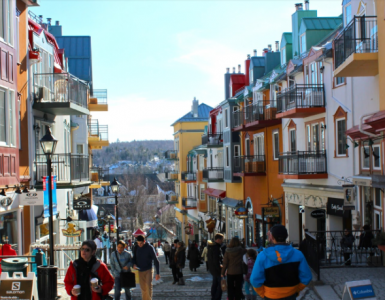Warren Miller inspired legions of skiers with his goofy, self-narrated ski-bum films. After the sale of his company—and a lawsuit—Miller agreed to never appear in, narrate, or direct another ski film. But now, nearing 90, he refuses to go downhill.
IN THE OPENING MOMENTS OF WARREN MILLER’S 1984 FILM SKI COUNTRY, which is considered a classic of the genre he created, the self-taught narrator-director-producer advises viewers to “hang on tight, ’cuz here we go.”
“We’re going to ski where there’s no lift lines, and no bad snow either,” Miller narrates. “We’re going on a six-month, around-the-world ski trip, and I’m going to be your guide.” The next 90 minutes are filled with slo-mo shots of skiers backflipping off cliffs, plunging into waist-deep powder, carving S-turns through frostings of white, and crashing spectacularly in explosions of snow. There are also bloopers, corny jokes, pretty women, and a madcap series of wipeouts by people tobogganing on air mattresses.
All the elements that fans had come to rely on year after year are there: extreme skiing, exotic locations, silly sequences, and hokey but earnest narration, peppered with the bons mots fans call Warrenisms—“Whatever resort you are at, that is the best one in the world.” Released in the VCR era, such films are becoming harder to find, but fans can still view excerpts on YouTube, where one person recently commented on the opening of Ski Country: “Is there anything better than kicking off the winter season with a Warren Miller film? The new ones are still great but I miss that voice!”
Unless you’re a skier, Warren Miller may be the most prolific filmmaker you’ve never heard of. In addition to dozens of ski movies, he’s directed films about sailing, surfing, and off-road racing during half a century of hauling camera gear around the world. He’s inspired generations of extreme-sports filmmakers, having practically invented the blooper-filled format that’s now a staple of ESPN, Fuel TV, and YouTube.
Now 87 and semiretired, Warren Miller divides his time between Orcas Island and the Yellowstone Club, a Montana ski resort. His loose definition of “semiretired” means he no longer makes films (and in fact is now legally barred from doing so, due to a dispute following the sale of his production company), but he continues to write books, newspaper columns, and his autobiography, while occasionally lecturing, raising funds for charitable causes, and comanaging the Warren Miller Freedom Foundation, which teaches business skills and entrepreneurship to youth.
Though he can seem like a lovable-but-gruff curmudgeon, Miller is actually a softie, a sentimentalist, and a patriot. He’s traveled to spectacular spots across the globe, but still feels that “America is the best place to live.” Even so, some friends were surprised by his early-1990s decision to call the Pacific Northwest home.
MILLER NEVER EXPECTED to end up here, having spent most of his life in Southern California. He had been living in Hermosa Beach, where he owned a house, his office building and studio, and other real estate. When he wasn’t traveling and skiing, he was at the beach or on the water, surfing or sailing or swimming. He hates ski resorts in the muddy and barren off-season—“nothing worse than walking around, looking up and seeing no snow and saying, ‘Well, what are we going to do today?’”
Miller soon committed himself fully to the pursuit of an unfettered life, driven by a belief that “the basic instinct of man is freedom.”
Then, in 1984, he met Laurie Kaufmann, who owned a ski shop and school in Seattle. Several months later, Warren joined Laurie and a group of friends for a bike ride around San Juan Island. As the gang left Anacortes, Miller stood on the ferry deck and, looking back into its wake, saw one of those picture-postcard scenes: a sailboat framed by the looming bald-white peak of Mount Baker. “It just turned me inside out,” he said. “I had never seen anything that pretty, that beautiful.”
After he and Laurie married, in 1988, they spent a decade living in Vail and Maui. But Warren never forgot that ferry ride and in 1992 he and Laurie decided to settle on Orcas Island, where they bought waterfront property and built a home. He realized he could indulge his two loves—sea and snow. “It filled, if you will, every one of my needs,” he said. “And I was with Laurie, and that filled them all up.”
BORN IN HOLLYWOOD in 1924, Miller grew up with “almost zero supervision” along with his two sisters. He describes his father as “a drunk” who lost it all during the Crash—“mentally and emotionally.” After moving to Topanga Canyon around 1930, the family struggled and Miller, at age eight or nine, started working at a grocery store for 10 cents a day. He later took on an early-morning paper route, so he’d be free after school to sprint to the beach.
He’d start each day by making himself a bowl of oatmeal, and would bring a peanut butter sandwich to school. “Peanut butter and oatmeal is what I grew up on,” he said. “That’s just the way it was.” But he learned there were benefits to limited adult supervision, such as having the freedom to roam the beach, body surfing and swimming.
An obsessive surfer, he learned to build his own boards—first redwood, then fiberglass—and befriended others who pioneered such now-famous surf spots as San Onofre and Malibu. At times during the 1930s and ’40s, he’d be the only guy in the water.
His first time on skis came around age 13, and he realized: This was real freedom—no coaches, no court, no opponent, no ball. He credits the Boy Scouts for coaching him and exposing him to the outdoors. While friends and classmates were playing basketball and football on the weekends, Miller was skiing or backpacking with his scout troop. “When I got back on Monday, they were talking about the football game and I was talking about some trouts I caught in a stream,” he said.
When he saved enough money to buy a camera, he would complement his Monday-morning story sessions with photos—an early version of the multimedia ski film presentations he would later give to packed houses. “So I gradually became a storyteller,” he said. “I don’t know whether I became the story or the story became me. But that desire to share ‘what I did this weekend’ really became an important part of my life.”
Oddly, the U.S. Navy reinforced his sense of freedom. As he describes it, his stint as a sailor toward the tail end of World War II (including the sinking of his boat in a hurricane) “broke the cycle of dysfunction.” In the Navy at least he had his own bed and good food.
Miller was discharged in mid-1946 and used his $100 mustering-out payment to buy an 8mm film camera. Later that year, he decided he wanted to see more than the mountains of Southern California, and set his sights on Sun Valley, Idaho. He convinced a surfing buddy, Ward Baker—“another guy as dumb as I was”—to travel with him. Together, they experienced the “terrible winter of 1946,” as Miller calls it. Together, they launched Miller’s career as a filmmaker.
WHEN HE LOOKS BACK on his escape from a childhood of want, and his slow rise to moviemaking success, Miller mostly credits his own entrepreneurship and zeal for freedom. But he rarely fails to thank the creator of the oyster cracker, without which he wouldn’t have survived the winter of ’46–’47.
He and Ward Baker towed a secondhand, teardrop-shaped camper behind Miller’s old Buick. At Sun Valley, they lived in the parking lot, curled in their army-surplus sleeping bags inside the unheated trailer. They’d sometimes awake to find five-foot snowdrifts engulfing their trailer.
Skiing by day on forged or bartered-for lift tickets, they dined occasionally on roadkill and frequently on salted ketchup and water—their version of tomato soup. They crammed their watery bowls full of oyster crackers, packets of which they filched from the cafeteria.
Using Miller’s new camera, the two men filmed each other and their snowbound trailer and their newfound ski-bum friends. Back in Southern California, they shared these home movies with surfer pals, as Miller narrated the action. Miller once estimated that expenses for the entire winter were less than $300. A year later, they did it again, and came home with more silent films of their snowy exploits.
Despite the threats of frostbite and arrest, despite being hungry, cold, and smelly, despite sleeping feet to face in an eight-by-four-foot trailer, Miller had found his calling. The two men shared an ability to handle spartan and uncomfortable conditions, and their scrappy, survivalist tactics would become hallmarks of the slacker lifestyle. Miller and Baker worked as ski patrols and instructors, washed dishes, and occasionally shot and killed rabbits for dinner. Miller sold hand-drawn cartoons and black-and-white ski photos to tourists for a dollar, using all his profits to buy more film. He soon committed himself fully to the pursuit of an unfettered life, driven by a belief that “the basic instinct of man is freedom.”
At the time, by Miller’s reckoning, there were fewer than 20 ski lifts in the U.S., which meant there was no guarantee skiing would become a mainstream sport, let alone a big enough industry to sustain a filmmaking career. (Similarly, Miller’s other passion—surfing, which he also filmed—was in its own infancy.) But Miller wasn’t thinking long term. Just like modern-day YouTube pioneers, he was having fun while experimenting in an untested medium, lugging his camera and tripod up and down the slopes, teaching himself about lighting and editing and storytelling.
Then, in one of those turning points of life, he got some serendipitous help from an ideal patron.
At Sun Valley in the late 1940s, Miller got talking with one of his ski school students, a slightly older guy who wanted to know what Miller was going to do with the rest of his life. Miller described his interest in creating travel films and getting into the “travel-lecture business.”
The student was Charles “Chuck” Percy, the new president of Bell and Howell camera company. He appreciated Miller’s enthusiasm and the next day told Miller that he had decided to loan him one of the company’s new hand-cranked 16mm cameras, which had an innovative swiveling lens with a wide angle and a telephoto. Percy (later to become a U.S. senator from Illinois) told Miller he could pay for the camera over time, in installments. The first few days after it arrived—in a red-velvet-lined box—Miller slept with the camera beside him.
It would take three years, but Miller finally paid off the camera—and validated Percy’s faith—as his filmmaking career slowly took flight.IN 1950, MILLER premiered his first real film, Deep and Light, with showings in Port Angeles, Seattle, and Vancouver, BC, the start of a film-a-year cycle. At first he showed his films in auditoriums to ski clubs, describing the action with live narration. Later he’d add voiceovers and music to his films. Traveling to dozens of cities each year to vocally and visually tell ski stories became his career, his livelihood, and his road to wealth, endearing him to skiers and fans around the world.
For those who haven’t seen Warren Miller’s earlier films, a full understanding of their appeal requires some distance from the “extreme” and “ultimate” and “insane” messages of recent documentaries about skiing (as well as snowboarding, skateboarding, surfing, and the like). Miller wasn’t the guy jacked up on Red Bull, screaming in your ear. Nor was he the moody sage, whispering about the soul of skiing. He was your half-drunk uncle. (Though, it must be said: Miller doesn’t drink.) He was the funny uncle who shared witty stories with a dry delivery, never embellishing, never yelling; cracking wise one moment, then dropping an intentionally corny joke the next. He openly admired the pretty ski bunnies and was outwardly thankful to the clothing designers who created slim-fitting winter clothes for women. Ward Baker liked to say, “Any girl looked good in ski clothes.”
But Miller also appreciated, without malice, the novices in their rental gear, whose wipeouts provided some of his best material. Miller has collected more footage of snowy face-plants than any human has, or will. In Snow Country he introduces viewers to a woman named Zenda, her sweatshirt-and-blue-jean-wearing boyfriend Clyde, “and her sister, Clara Klutz.” That formula—extreme but real—worked for many fans, year after year, in films such as No Boundaries, Winter Fever, Snowonder, Steep and Deep, and White Magic. The films typically lasted 90 minutes, Miller’s melodic voice narrating throughout, with bits of history about each locale. Miller liked to think of them more as travelogues than “ski films.”
In addition to giving talented skiers a chance to show their stuff, Miller’s goal was to expose people to the greater world of skiing. And by obsessively and playfully documenting that world, and by making it all look so damn fun, he helped the sport grow. One of Miller’s longtime friends is Dave McCoy (above), who founded California’s Mammoth Mountain Ski Area. Miller visited Mammoth early in his career, and would show his films to guests. McCoy found Miller to be a passionate evangelist for skiing, someone who worked hard while relentlessly pursuing the fun and freedom of outdoor sports. “I thought he was one of the more fanatical individuals,” McCoy said. “He’d go skiing for a day and make a dozen friends.”
These days, anyone with a smartphone can make a film. In the 1950s and ’60s, it took a bigger commitment. McCoy remembers one winter when Miller visited Mammoth to shoot a film and asked if he could park his car and trailer in the lot. More than once McCoy would have to dig Miller out in the morning. Miller has always been proud of his do-it-yourself methods, his cheap meals, his ability to drive from town to town, shooting and showing his films, eating and living cheaply, sometimes sleeping in his car, “but having fun,” said McCoy. (Warrenism: “Wherever you go skiing, spare no expense to make your trip as cheap as possible.”)
His joy came through on the screen, and his films made people laugh. But by the 1980s, having lost his first wife to cancer, and divorcing twice after that, Miller was laughing less. He decided to make some changes.
JUST AS HE HAD WITNESSED the growth of surfing from an oddball Southern California pastime, Miller had watched skiing explode into a popular and increasingly expensive sport. In his mid-60s, he decided, after dozens of ski films and scores of shorter documentaries about other sports, that it was time to step back, slow down, travel less.
In 1988, he bequeathed his company, Warren Miller Entertainment (WME), to his son, who later sold the company to Time Warner, which in 2007 sold it to the Swedish media conglomerate Bonnier Group. Miller stayed aboard to write and narrate the annual films, but began to resist the new owners’ efforts to make the films sexier and more extreme. Then Miller appeared briefly (and off camera) in another director’s 2009 ski film, and WME sued, claiming that Miller no longer owned the rights to his own “name…voice, and likeness.”
The suit was settled in late 2010, with Miller agreeing to never appear in, narrate, or direct another ski film. The brand he’d created was no longer his. So when the 61st annual film, Warren Miller’s Wintervention, premiered in late 2010, the godfather of snow porn had no creative connection with the film bearing his name, which had been the case for years.
Then again, the dispute with his company’s owners brought clarification and focus to what Miller can and can’t do with his lifetime of ski stories. The judge in the case ruled that Miller could legally use his name and likeness in other ventures, a ruling that seems to have invigorated Miller, who seems incapable of a quiet retirement. He now works for two new ventures, the Warren Miller Freedom Foundation, founded by his wife and his stepson, Colin Kaufmann, and the Warren Miller Company, founded by Colin. He also started compiling a book of his ski photography, revived his autobiography project, and launched a series of storytelling sessions, called “An Evening with Warren Miller.” At the sold-out inaugural event at Seattle’s Benaroya Hall in 2010, he was funny, riveting, and unexpectedly poignant.
At the same time, he occasionally seems troubled by what’s happened over the past few years, and by the limits placed on his freedom. After seven decades of skiing, he sustained one of his first skiing injuries two years ago. Though he’s been working on a book about aging gracefully, Miller isn’t entirely on good terms with the aging process, despite the advice he’s given in a film or two: “Don’t take life seriously because you can’t come out of it alive.”
Movie-star handsome as a young man, Miller kept his tanned good looks well into his AARP years. And today, though rounder and balder, he hardly looks like he’s approaching 90. Still, he’s no longer the man who relentlessly skied the world. Inevitably, he’s slowed down. And lately he’s been focusing his energies less on skiing and more on philanthropy and his own legacy.
One of his recent projects was raising funds to build a world-class skateboard park on Orcas Island, which fits within the freedom-seeking motif of his life. In baseball, he says, the worst player is stuck out in right field, and at least nine players lose every game. “In surfing, skiing, and skateboarding, everybody wins,” he says. Miller still gets choked up when he tells this story of the autistic boy whose parents brought him to skate at the Orcas Island skate park. They later called to tell Miller what happened during the drive back home to California. The boy uttered the first words of his life: “Dad, can I have a hamburger?”
By Neal Thompson


